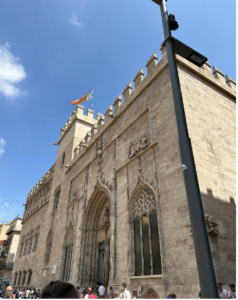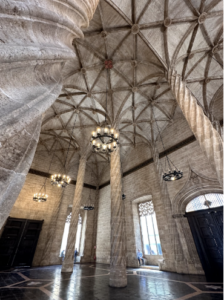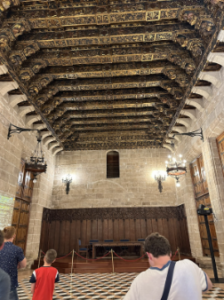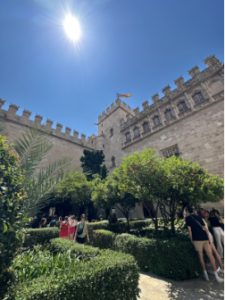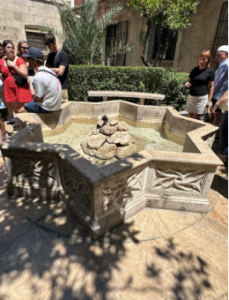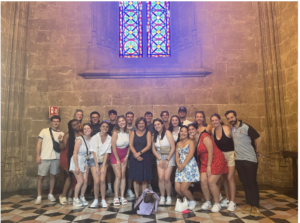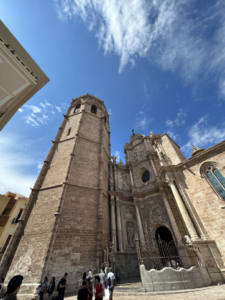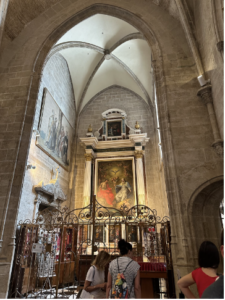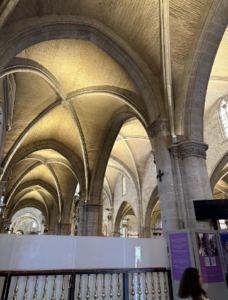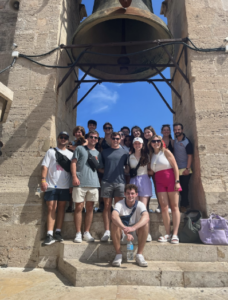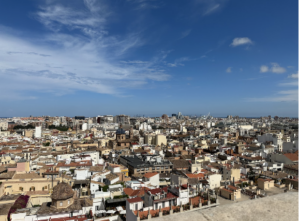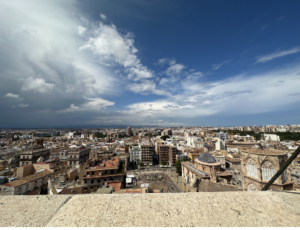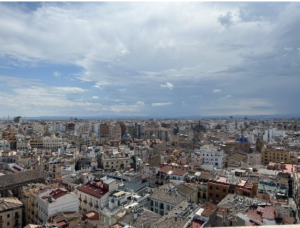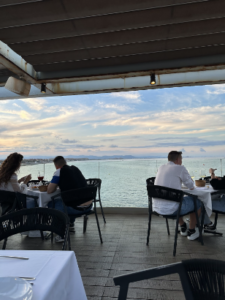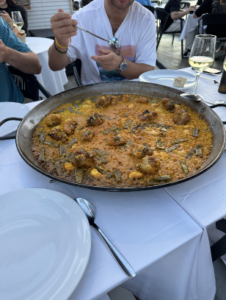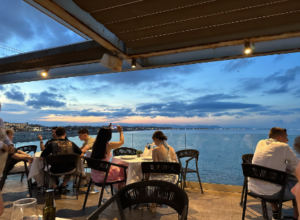Written by: Avery Byrne (Session 1)
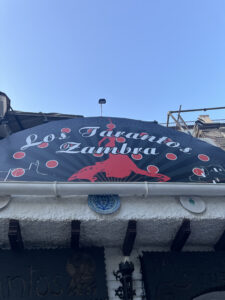 After several tiring yet thrilling days of traveling from Córdoba to Seville, we spent three exciting days in Granada, the second of which was one of my favorite days of this maymester so far. We started the afternoon by piling on the bus and instantly discussing our excitement for the flamenco show we were heading to. We quickly arrived at a small building with “Los Tarantos Zambra” written over a bright red flamenco dancer’s silhouette. As we walked into the building, my curiosity was instantly piqued. We were surrounded by different colored lights, hanging plates with eye-catching details, and various paintings.
After several tiring yet thrilling days of traveling from Córdoba to Seville, we spent three exciting days in Granada, the second of which was one of my favorite days of this maymester so far. We started the afternoon by piling on the bus and instantly discussing our excitement for the flamenco show we were heading to. We quickly arrived at a small building with “Los Tarantos Zambra” written over a bright red flamenco dancer’s silhouette. As we walked into the building, my curiosity was instantly piqued. We were surrounded by different colored lights, hanging plates with eye-catching details, and various paintings.
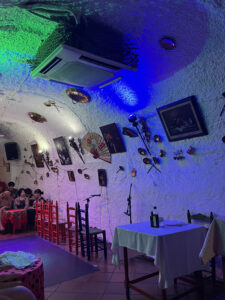
Our group was ushered through a red door into a very narrow room that resembled a cave. We were seated in a line on the left side of the room with a flamenco floor, five chairs, and a microphone in front of us. I found myself intently looking around the room at the paintings, fans, and what looked like kitchen ladles on the walls. After patiently waiting, the lights finally dimmed as the first flamenco group entered the room. The group consisted of three dancers, one singer, and one guitarist. I did not know what to expect from the live show, but I was pleasantly surprised and inspired. The show began with a powerful belt from the singer accompanied by the passion of the guitarist. After several measures, the first female dancer stood up to perform her solo pieces. At first, I was attentively paying attention to the detail that she added to every movement and the intricacy of each step she made. I was quickly captivated by her ability to emote as she was performing such a technically difficult piece. I noticed that each of the three dancers expressed what I observed to be a level of hurt, pain, and passion which I later learned in class was an expression of duende. Throughout the duration of the group’s performance, I continued to focus on each of the dancer’s facial expressions and the way in which their passion matched each movement. I tried to also listen to the palmas patterns that the other group members were doing as one dancer was performing as it was interesting to me how these also helped guide the dancer. I found it so impressive how the dancer’s emotions not only matched their movements, but also the palmas, expression of the guitarist, the expression of the singer, and the changing speeds of the music.
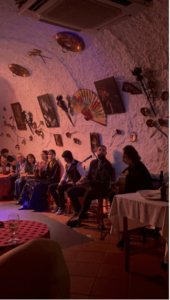
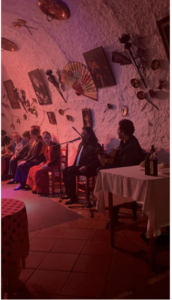
Flamenco Group 1 Flamenco Group 2
The second flamenco group was different than the first, though the performance structure was similar. It was easy to see the similarities in tradition, but I thought it was fascinating to see how each dancer distinguished themselves through their personal expression. In the second performance, the singer emoted himself in a very powerful way and would sing while the dancer was performing, whereas in the first, the singer would stop during the performance. In the second performance, an older woman performed with the inclusion of castanets, which was an aspect of flamenco that we had not yet seen. I was completely entranced as I was trying to comprehend how she was putting meticulous detail into her dance technique, her passionate emotion, matching her movements to the other group members, and playing castanets all at once.
Throughout both performances, I was unable to not focus on the emotions of each dancer as they expressed themselves and their souls. The experience of attending this flamenco show was extremely special to me in order to understand how flamenco music and performance plays a large part in the national identity of Spain and it was an amazing experience to share with the group.
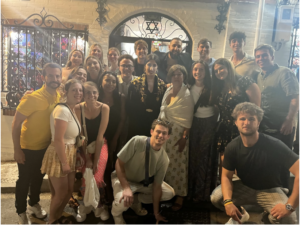


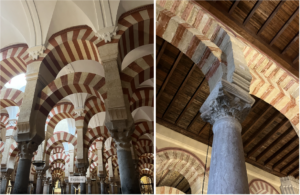
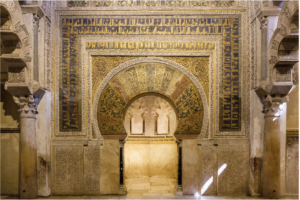
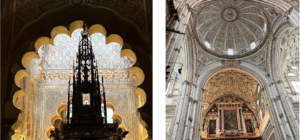
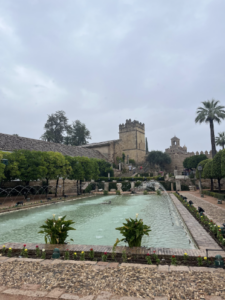 Una pregunta que tuve mientras viajamos por el sur de España – Córdoba, Sevilla, y Granada – fue si la Reconquista completamente borró a los musulmanes de la región. En nuestros viajes, vi como la religión y la cultura musulmana puede influir en una sociedad cristiana. Nuestro primer día en Córdoba, visitamos el Alcázar de los Reyes Cristianos, un lugar muy bonito y lleno de historia. Aquí, vi como aunque el espacio fue un espacio cristiano, todavía tenía influencia musulmana. Lo que es más obvio es el nombre. “Alcázar,” como aprendí, es una palabra árabe para un palacio real. Otra cosa que noté era la presencia de agua en los jardines en el Alcázar. Como los profesores me dijeron, los cristianos típicamente no se bañaban mucho. Por lo tanto, los musulamanes, cuando llegaron a España, introdujeron agua, y los reyes cristianos guardaron esta tradición y la adaptaron a su cultura. En nuestro segundo día, vimos patios cristianos que eran muy hermosos. Las flores eran brillantes; el agua brillaba con luz trémula. El olor de naranjas maduras colgaba en el aire. Aprendí que todos estos aspectos – los patios, la presencia de las flores y las frutas cítricas – son intrínsecamente musulmanes. Una vez más, vi cómo los cristianos adaptaron otra cultura en la suya.
Una pregunta que tuve mientras viajamos por el sur de España – Córdoba, Sevilla, y Granada – fue si la Reconquista completamente borró a los musulmanes de la región. En nuestros viajes, vi como la religión y la cultura musulmana puede influir en una sociedad cristiana. Nuestro primer día en Córdoba, visitamos el Alcázar de los Reyes Cristianos, un lugar muy bonito y lleno de historia. Aquí, vi como aunque el espacio fue un espacio cristiano, todavía tenía influencia musulmana. Lo que es más obvio es el nombre. “Alcázar,” como aprendí, es una palabra árabe para un palacio real. Otra cosa que noté era la presencia de agua en los jardines en el Alcázar. Como los profesores me dijeron, los cristianos típicamente no se bañaban mucho. Por lo tanto, los musulamanes, cuando llegaron a España, introdujeron agua, y los reyes cristianos guardaron esta tradición y la adaptaron a su cultura. En nuestro segundo día, vimos patios cristianos que eran muy hermosos. Las flores eran brillantes; el agua brillaba con luz trémula. El olor de naranjas maduras colgaba en el aire. Aprendí que todos estos aspectos – los patios, la presencia de las flores y las frutas cítricas – son intrínsecamente musulmanes. Una vez más, vi cómo los cristianos adaptaron otra cultura en la suya. 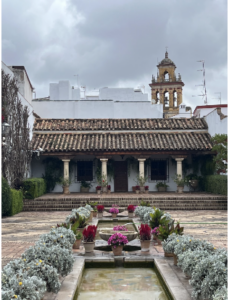 Otros lugares que tenían esta mezcla de culturas fueron la mezquita de Córdoba y la Alhambra en Granada. Ahora en día, la mezquita es una catedral, pero todavía hay elementos de la mezquita original. Por ejemplo, los arcos de rojo y blanco son un elemento musulmán. Hay espacios en la mezquita/la catedral donde los elementos de las dos casas de adoración se cruzan. Para mí, esto muestra cómo hay espacio para más de una religión o una cultura, y cómo todos podemos vivir juntos. Finalmente, quiero hablar un poco sobre la Alhambra, que está en Granada, la última ciudad que cayó a los cristianos durante la Reconquista. Una vez más, este lugar es una mezcla de las dos culturas. Un aspecto que fue interesante para mí es que las viñas son una característica musulmana.
Otros lugares que tenían esta mezcla de culturas fueron la mezquita de Córdoba y la Alhambra en Granada. Ahora en día, la mezquita es una catedral, pero todavía hay elementos de la mezquita original. Por ejemplo, los arcos de rojo y blanco son un elemento musulmán. Hay espacios en la mezquita/la catedral donde los elementos de las dos casas de adoración se cruzan. Para mí, esto muestra cómo hay espacio para más de una religión o una cultura, y cómo todos podemos vivir juntos. Finalmente, quiero hablar un poco sobre la Alhambra, que está en Granada, la última ciudad que cayó a los cristianos durante la Reconquista. Una vez más, este lugar es una mezcla de las dos culturas. Un aspecto que fue interesante para mí es que las viñas son una característica musulmana. 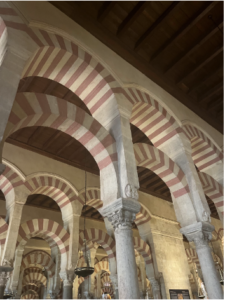
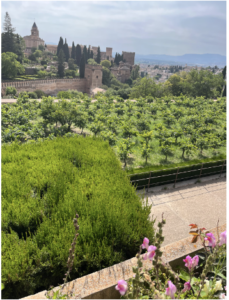 Para terminar mi blog, quiero regresar a mi primera cuestión:
Para terminar mi blog, quiero regresar a mi primera cuestión: 